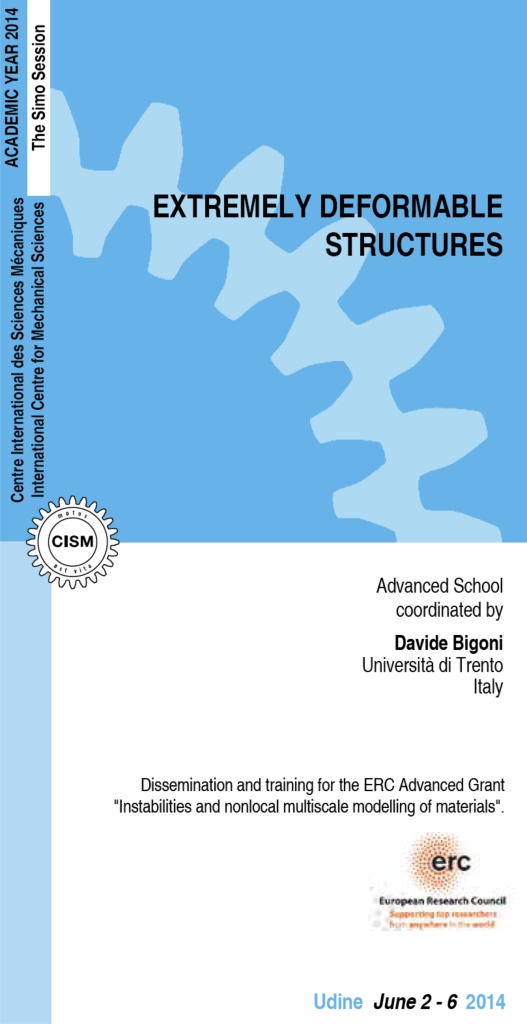The Journal Club Theme of February 2012 "Elastic Instabilities for Form and Function" (node/11812), coordinated by Doug Holmes (http://www2.esm.vt.edu/~dpholmes/), has provided an excellent review of elastic instability as related to pattern formation in soft materials.
The October 2012's Journal Club is on a closely related subject, namely, "instabilities of structures". This is a mature research field, but still strongly vital. In particular, we would like to draw the attention on recent results on how to exploit the post-critial behaviour of an elastic structure to obtain flexible mechanisms with special behaviours: (i.) a spherical shell shrinking towards its center; (ii.) a one-degree-of-freedom elastic structure buckling in tension and compression and providing a constant force ("neutral") post-critical behaviour; (iii.) dynamical instabilities explain wrapping of a liquid drop by an elastic strip.
(i.) A spherical shell shrinking towards its center
A spherical shell patterned with a regular array of circular engraves is shown to buckle, when subject to external pressure, in a sort of torsional-mode, giving rise to a shrink of the shell toward its center (Shima et al. 2012), Fig. 1.
This folding mechanism is induced by a mechanical instability in an elastic structure and therefore is fully reversible.
![]()
Fig. 1 Sequence of progressively deformed shapes of the buckliball (from Shima et al. 2012)
A video on the buckliball can be found at: http://www.youtube.com/watch?v=pKdWa8aIqno
(ii.) A one-degree-of-freedom elastic structure buckling in tension and compression and providing a constant force ("neutral") post-critical behaviour
Zaccaria et al. (2011) have shown that elastic structures (in which each element is governed by the Euler's elastica) can be designed to buckle under purely tensile dead loading and that the shape of the buckled elastica in tension corresponds to the shape of a water meniscus in a capillary channel (Fig. 2).
![]()
Fig. 2 Analogy between an elastic rod buckled under tensile force (left) and a water meniscus in a capillary channel (right, superimposed to the solution of the elastica, marked in red): the deflection of the rod and the surface of the liquid have the same shape (from Zaccaria et al. 2011)
These concepts have been developed by Bigoni et al. (2012) to show that the profile of the constraint where an end of an elastic structure has to slide can be designed to obtain buckling in tension or compression, and two buckling loads for a one-degree-of-freedom structure. Moreover, the profile can be designed to obtain a "neutral" postcritical response, in which the displacement increases at constant load (Fig. 3).
![]()
Fig. 3 A one-degrees-of-freedom elastic structure with two (one tensile and one compressive) buckling loads and neutral postcritical behaviour. Right: experimental set-up. Left: theoretical predictions versus experimental results (from Bigoni et al. 2012)
A video on multiple bifurcations and neutral postcritical response can be found at: http://www.youtube.com/watch?feature=player_embedded&v=plQqUGFYegw
(iii.) Dynamical instabilities explain wrapping of a liquid drop by an elastic strip
Experiments by Antkowiak et al. (2011) show that a liquid drop can be wrapped by an elastic thin film by a drop impact on millimetric and centimetric scales (Fig. 4). This capillary phenomenon, is competing with the weight of the elastic film and can be explained (Rivetti and Neukirch, 2012; Hure and Audoly, 2012) in terms of elastic instability.
![]()
Fig. 4 Instant capillary origami, obtained with a water droplet impacting a thin triangular polymer sheet with thickness (from Antkowiak et al. 2011).
A video on the wrapping of liquid drops can be found at: http://www.youtube.com/watch?v=-FewxlkYOME
In the previously-quoted works, the theoretical predictions are substantiated with experiments and a close agreement is shown, so that we may think that it will be possible in the future to realize flexible structures with designed pre- and post- critical behaviours. Results presented in (i.) and (iii.) can find applications in the industrial process of encapsulation, while results presented in (ii.) can be employed to design of shock-absobers for tensile forces.
References
A. Antkowiak, B. Audoly, C. Josserand, S. Neukirch, and M. Rivetti (2011) "Instant fabrication and selection of folded structures using drop impact". PNAS 26, 108, 10400–10404.
D. Bigoni, D. Misseroni, G. Noselli and D. Zaccaria (2012) Effects of the constraint’s curvature on structural instability: tensile buckling and multiple bifurcations. Proc. R. Soc. A, 468, 2191-2209.
J. Hure, B. Audoly (2012) Capillary buckling of a thin film adhering to a sphere. J. Mech. Phys. Solids, DOI: http://dx.doi.org/10.1016/j.jmps.2012.09.016.
M. Rivetti and S. Neukirch (2012) "Instabilities in a drop-strip system: a simplified model." Proc. R. Soc. A doi:10.1098/rspa.2011.0589
J. Shima, C. Perdigoub, E.R. Chen, K. Bertoldi, and P.M. Reis (2012) "Buckling-induced encapsulation of structured elastic shells under pressure", PNAS 109, 16, pp. 5978-5983.
D. Zaccaria, D. Bigoni, G. Noselli and D. Misseroni (2011) Structures buckling under tensile dead load. Proc. R. Soc. A, 467, 1686-1700.










